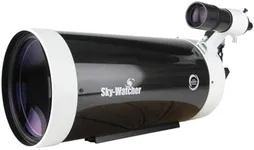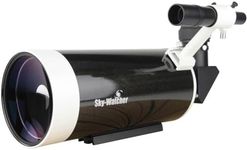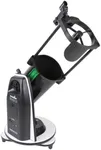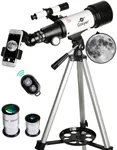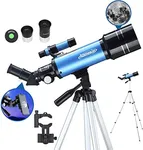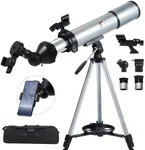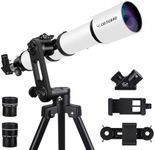Buying Guide for the Best Astronomical Telescopes
Choosing the right astronomical telescope can be a thrilling yet daunting task, especially for beginners. The key to making the best choice is understanding the specifications that matter most and how they align with your observing goals. Whether you're interested in viewing planets, deep-sky objects, or just casual stargazing, knowing what to look for in a telescope will help you make an informed decision.ApertureAperture refers to the diameter of the telescope's main optical component (lens or mirror). It is crucial because it determines how much light the telescope can gather, which directly affects the brightness and clarity of the images you see. Apertures can range from small (around 60mm) to large (over 200mm). For beginners, a medium aperture (around 100-150mm) is often a good balance between portability and performance. Larger apertures are better for viewing faint deep-sky objects but can be more cumbersome and expensive.
Focal LengthFocal length is the distance between the telescope's main optical component and the point where it forms an image. It affects the magnification and field of view. Short focal lengths (under 1000mm) provide wider fields of view, which are great for observing large areas of the sky and deep-sky objects. Longer focal lengths (over 1000mm) offer higher magnification, ideal for viewing planets and the moon. Consider what you want to observe most often to decide the right focal length for you.
Mount TypeThe mount is what holds the telescope steady and allows you to aim it. There are two main types: alt-azimuth and equatorial. Alt-azimuth mounts are simpler and easier to use, making them great for beginners and casual stargazing. Equatorial mounts are more complex but allow for better tracking of celestial objects, which is essential for astrophotography and serious observing. Choose a mount based on your experience level and observing goals.
Optical DesignTelescopes come in different optical designs, such as refractors, reflectors, and compound (catadioptric) telescopes. Refractors use lenses and are known for their sharp images and ease of use, making them good for beginners. Reflectors use mirrors and offer larger apertures at lower costs, ideal for deep-sky observing. Compound telescopes combine lenses and mirrors, providing versatility and compactness, suitable for both planetary and deep-sky observations. Your choice should depend on what you prioritize: image quality, cost, or versatility.
PortabilityPortability refers to how easy it is to transport and set up the telescope. Smaller, lighter telescopes are easier to carry and set up, making them ideal for casual stargazing and travel. Larger telescopes offer better performance but can be heavy and cumbersome. If you plan to observe from different locations or travel frequently, a more portable telescope might be the best choice. If you have a permanent observing spot, you can opt for a larger, less portable model.
AccessoriesAccessories can enhance your observing experience. Common accessories include eyepieces, finderscopes, and filters. Eyepieces determine the magnification and field of view; having a variety allows you to adjust based on what you're observing. Finderscopes help you locate objects in the sky more easily. Filters can improve the visibility of certain celestial objects. Consider what accessories are included with the telescope and what additional ones you might need based on your observing interests.



